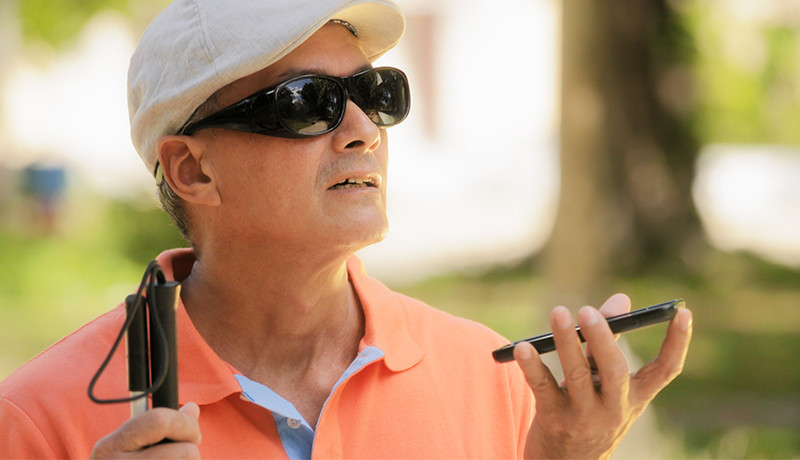Three Blindness-Aware Mobile Navigation Apps

Most GPS navigation platforms do not include a full set of features and functions for traveling with a cane or guide dog. In this section, we will introduce you to three mobile GPS navigation apps, one for Google Android and the other two for Apple iOS, which ave been designed from the ground up to accommodate the special needs of the vision impaired. All three of these apps have been extensively reviewed in AFB’s AccessWorld, and we will provide links to each of these articles as we briefly introduce them here. We will also take an in-depth look at the enhanced functionality offered by these “blindness aware” mobile apps, and demonstrate how purchasing and installing one or more of them can enhance your mobility and make independent travel easier, safer, and much more enjoyable.
Nearby Explorer for Android
Nearby Explorer from the American Printing House for the Blind, available for a one time charge of $99 from the Google Play Store, was reviewed in the October 2014 issue of AccessWorld. Unlike the other mobile apps we will describe in this section, Nearby Explorer installs a complete set of NAVTEQ maps on your device. This allows most of the app’s features to work without a data connection. Currently, there is no trial version.
The Seeing Eye GPS App
The Seeing Eye GPS App from Sendero Group, reviewed in the November, 2013 issue of AccessWorld, is available in two versions. You can purchase the Seeing Eye GPS XT App for a one-time charge of $299. You can also download the standard app for free and then choose one of three subscription plans: one month for $9.99, one year for $69.99, or three years for $129.99.
The Seeing Eye GPS app Version 2.0 uses Google Maps only for navigation. It uses either TomTom or Foursquare for points of interest. (See below for a description of Open Streets Maps and Foursquare.) Seeing Eye also doesn’t give haptic feedback on the maps view like Nearby Explorer does. Other than that it looks
The Seeing Eye GPS app map and POI information are stored on company servers, so you will need a data connection to access most features.
BlindSquare
BlindSquare from MIPsoft was reviewed in the July 2014 issue of AccessWorld. It is available for $29.99 from the iTunes App Store.
One of the reasons this app is much less expensive than the other two mentioned above is because it does not provide turn-by-turn directions. Instead, the app passes this function off to your choice of installed navigation apps including Apple Maps and Google Maps. Additionally, for location and other POI information, the developer has eschewed expensive commercial mapping solutions in favor of relying exclusively on free location databases, primarily Open Street Maps and Foursquare.
Open Street Maps is a crowd-sourced project that was founded in 2004 with the goal of providing accurate mapping data that would be available without charge to individuals, app developers, and technology solutions around the world. Foursquare is a social connector, a way to keep track of where your friends are and what they are doing right now. You can post your current location by checking in using a smartphone app so your friends can also find you. Frequent check-ins garner points and badges. Increasingly, businesses are offering discounts to people who check infrequently, and if you are the person who checks in most at a restaurant, bookstore, or other location, you may even be designated that place’s mayor. With millions of Foursquare users regularly adding and checking into locations, it has become one of the largest and most frequently updated POI databases available.
This article was written and published by the American Foundation for the Blind. <Click Here> to read the article in its entirety and access their related articles.
We Are Here To Bring Hope
If you or a loved one have been diagnosed with Macular Degeneration, we have prepared a 12-part eBook <Click here to download a PDF of the entire report.>
To learn more about how we can Bring Hope to people who are blind or with low vision, contact a Technology Specialist at New England Low Vision and Blindness to learn more. You can also call our toll free number 888-211-6933 or email us at info@nelowvision.com.
Our two(2) state-of-the-art technology showrooms are a wonderful resource, showcasing a variety of leading electronic low vision magnifiers and blindness products. You can schedule an appointment with one of our Technology Specialist who can help you find the right technology, training and care solution.
If you cannot come to us, our staff can even drive out and bring our Vision Store to you, for a no-obligation product demonstration. We offer a comprehensive line of products including electronic magnification low vision aids, blindness products, and leading low vision products for people with glaucoma, macular degeneration and other forms of vision loss.



